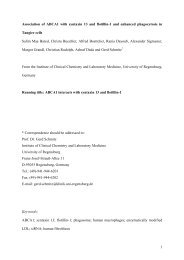SUNDAY, DECEMBER 4- Late Abstracts 1 - Molecular Biology of the ...
SUNDAY, DECEMBER 4- Late Abstracts 1 - Molecular Biology of the ...
SUNDAY, DECEMBER 4- Late Abstracts 1 - Molecular Biology of the ...
You also want an ePaper? Increase the reach of your titles
YUMPU automatically turns print PDFs into web optimized ePapers that Google loves.
<strong>SUNDAY</strong><br />
We set out to identify <strong>the</strong> determinants <strong>of</strong> SUN-KASH interaction and to understand complex<br />
formation in molecular detail. Using pulldown experiments, we were able to reconstitute SUN-<br />
KASH binding in vitro. We analyzed luminal constructs <strong>of</strong> human SUN1 and SUN2 expressed<br />
ei<strong>the</strong>r in <strong>the</strong> ER <strong>of</strong> Hela cells or purified from E. coli. Both <strong>the</strong> conserved SUN domains and <strong>the</strong><br />
preceding coiled-coil regions were required for interaction. Replacing <strong>the</strong> endogenous coiledcoils<br />
<strong>of</strong> SUN1 or SUN2 by an unrelated coiled-coil domain allowed efficient KASH binding. This<br />
indicates that oligomerization <strong>of</strong> SUN domains by coiled-coils is a key determinant <strong>of</strong> SUN-<br />
KASH interaction.<br />
The crystal structure <strong>of</strong> <strong>the</strong> complex between <strong>the</strong> SUN domain <strong>of</strong> human SUN2 and <strong>the</strong><br />
Nesprin-2 KASH domain (see poster presented by Brian Sosa and Thomas Schwartz) revealed<br />
essential features <strong>of</strong> SUN-KASH interaction in molecular detail. Using mutational analyses <strong>of</strong><br />
both binding partners, we confirmed <strong>the</strong> key determinants in in vitro binding assays.<br />
Fur<strong>the</strong>rmore, we could show that <strong>the</strong> disruption <strong>of</strong> SUN-KASH interaction affects nuclear<br />
envelope targeting <strong>of</strong> both SUN and KASH proteins.<br />
2022<br />
NSrp70 is a novel nuclear speckle-related protein and modulates alternative pre-mRNA<br />
splicing in vivo.<br />
Y-D. Kim 1 , J-Y. Lee 1 , K-M. Oh 1 ; 1 Life Science, Gwangju Inst Science/Technol, Gwangju, Korea<br />
Nuclear speckle is known to serve as <strong>the</strong> storing place <strong>of</strong> mRNA splicing regulators. We report<br />
here <strong>the</strong> identification and characterization <strong>of</strong> a novel speckle protein, referred to as NSrp70,<br />
based on its sub-cellular location and apparent molecular weight. This protein was firstly<br />
identified as <strong>the</strong> NSrp70, as <strong>the</strong> product <strong>of</strong> <strong>the</strong> NIH Mammalian Gene Collection, while no<br />
function has been assigned yet. NSrp70 was co-localized and physically interacted with both<br />
SC35 and ASF/SF2 in speckles. NSrp66 has putative RNA recognition motif, RE/RD rich<br />
domain, and two coiled-coil domains, suggesting role in RNA processing. Accordingly, using<br />
CD44, Tra2b1 and Fas constructs as splicing reporter minigenes, we found that NSrp70<br />
modulated alternative splice site selection in vivo. The C-terminal ten amino acids (aa) (531-<br />
540) including 536 RD 537 were identified as <strong>the</strong> novel nuclear localization signal, and <strong>the</strong> region<br />
spanning 290 to 471 aa was critical for <strong>the</strong> speckle localization and <strong>the</strong> binding to SC35 and<br />
ASF/SF2. The N-terminal region (107-161) was essential for <strong>the</strong> pre-mRNA splicing activity.<br />
Finally, we found that knockout <strong>of</strong> NSrp70 gene in mice produced no progeny including fetal<br />
embryos. Collectively, we demonstrate that <strong>the</strong> NSrp70 is a novel splicing regulator and<br />
essentially required earlier during embryonic development.<br />
2023<br />
Quality control and stress response in mammalian ribosomal biogenesis.<br />
M. Wang 1,2 , D. Pestov 2 ; 1 UMDNJ-GSBS, Stratford, NJ, 2 Cell <strong>Biology</strong>, UMDNJ-SOM, Stratford,<br />
NJ<br />
Ribosome is <strong>the</strong> subcellular component that translates mRNA to proteins. This complex<br />
molecular machine is composed <strong>of</strong> two subunits, and contains four different ribosomal RNAs<br />
(rRNAs) and 79 ribosomal proteins (RPs). The assembly <strong>of</strong> eukaryotic ribosomes is a multi-step<br />
process involving numerous <strong>of</strong> proteins and RNA factors. Compromised ribosome integrity<br />
contributes to premature aging syndromes, cancer and o<strong>the</strong>r diseases. Surveillance<br />
mechanisms act throughout <strong>the</strong> entire ribosome syn<strong>the</strong>sis pathway to eliminate defective<br />
intermediates and <strong>the</strong>reby promote structural and functional integrity <strong>of</strong> <strong>the</strong> final ribosomal<br />
particles. However, ribosome biogenesis is very sensitive to various disturbances <strong>of</strong> cellular
















